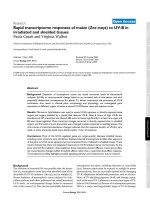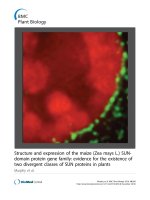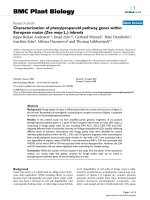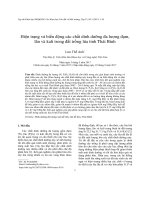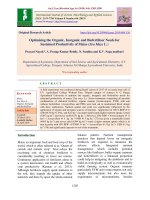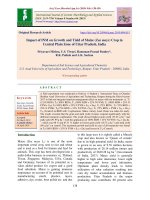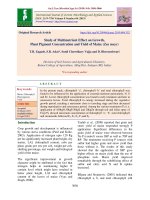Response of boron, copper, zinc nitrogen, phosphorus and potassium on some growth qualities of maize (Zea mays L.) plant
Bạn đang xem bản rút gọn của tài liệu. Xem và tải ngay bản đầy đủ của tài liệu tại đây (304.82 KB, 15 trang )
Int.J.Curr.Microbiol.App.Sci (2020) 9(8): 2382-2396
International Journal of Current Microbiology and Applied Sciences
ISSN: 2319-7706 Volume 9 Number 8 (2020)
Journal homepage:
Original Research Article
/>
Response of Boron, Copper, Zinc Nitrogen, Phosphorus and Potassium on
Some Growth Qualities of maize (Zea mays L.) Plant
M.L. Bubarai*, T. Thomas and N. Swaroop
Department of Soil Science and Agricultural Chemistry, Samhiggin Bottom University of
Agriculture Science and Technology, India
*Corresponding author
ABSTRACT
Keywords
Boron, Copper,
Zinc and NPK
Article Info
Accepted:
20 July 2020
Available Online:
10 August 2020
To study the response of Boron, Copper, Zinc, and NPK to the quality parameters
of maize plant a field experiment was set up at Samhiggin Bottom University of
Agriculture Science and Technology Prayagraj for two consecutive periods (2017
to 2018). The treatments consisted of 0, 3, 6, 9kg of Boron, zinc, copper /ha, and
0, 50 and 100kgNPK/ha respectively, and were arranged in a completely
randomized design and replicated three times. Soil samples were collected from
the field for routine analysis before planting. Plant parameters that were
investigated include number of leaves which was obtained by counting, nutrients
concentration in stems and leaves which were analyzed after samples were
collected oven-dried and ground into powdered form. Grain yield and stover were
also determined during harvest. The outcome of the investigations yielded a
significant impact of the fertilizers on plant height, the number of leaves,
concentrations of nutrients in plant parts and Yields of maize crop. The application
of 100kgNPK+9Kg B, Zn Cu ha-1 produces the best result. It is therefore advisable
to incorporate micronutrients whenever major nutrients are added to crops to
obtained maximum yield
Introduction
Maize or corn (Zea mays L) is a crop which
belonging to the family of grasses (Poaceae).
Maize is cultivated almost everywhere around
the world. It is one of the most staple cereal
crops especially in Africa. It has immense
potential in the tropics and great yield can be
obtained if the crop is properly managed. It is
also an important feed and fodder to livestock
and also a source of raw materials to many
industries around the globe. It has been
widely reported that maize has the capacity to
produce good quantity of biomass under a
very good integrated management condition
(Chaudhary et al., 2012). Industrially the
products which are obtained when maize is
use as a source of raw materials include corn
starch, maltodextrins, corn oil, corn syrup and
products of fermentation and distillation. In
2382
Int.J.Curr.Microbiol.App.Sci (2020) 9(8): 2382-2396
the highly advanced countries the crop is
harnessed to produce an alternative source of
fuel. Maize is a crop which is capable of
being cultivated over a wide range of agro
climatic conditions. It has the unique
characteristics to out with other crops to adapt
to various agro climatic zones. Despite all this
attributes the output is still very low, 5 t / ha
(FAO. 2007) this has created some lapses of
maize for its various usages. Some of the set
back which affect the yield of maize crop is
low return of nutrients to the soil after it has
been depleted as a result of cultivation, also
due to the inherent nature of the soil which is
low in nutrients status especially in the
developing community (FAO. 2007). This
phenomena hindered maize production as
maize has a strong exhausting effect on the
soil. It was generally observed by research
that maize fail to produce good grain in plots
without adequate nutrients (Adediran and
Banjoko, 2003). It has been observed that the
used of inorganic fertilizer has a profound
effect on yield and yield attributes of cereals
crops more especially maize (Stefano et al.,
2004). The following researchers (Fashina et
al., 2002., Saeed et al., 2000 and Obi et al.,
2005)observed that application of inorganic
fertilizer accelerate rapid cell division and
multiplication which leads to rapid growth,
development and production of dry matter
owing to better utilization of solar radiation
and more nutrient. Therefore maize crop
needs sufficient uptake of nutrients from soil
especially the macronutrients NPK and some
micronutrients like boron, zinc copper in
smaller amount for good growth and high
yields. The macronutrients in combination
with minute’s amount of boron, copper and
zinc are capable of improving the quality of
maize in all aspects.
Boron is micronutrients necessary for the
development and metabolism of plants. It is
an essential micronutrient, but it becomes
toxic if used slightly above the critical level.
It is necessary for the correct growth,
development and production of healthy
vegetables in plants. It is associated with the
introduction and development of growth
points, the transport of nutrients within the
plant, the formation of plant hormones that
affect growth, root growth and the health of
fleshy roots, the collection of flowers and
fruits and the quality and taste of vegetables.
It also contributes to disease resistance, cell
division, pollen germination and pollen
growth, B also aids in the movement of sugars
and starch in developing parts. Boron also
affects the colonization of mycorrhizae on the
surface of the root and, therefore, affects the
absorption of P (and also of K). It also
regulates the K / Ca ratio in plants. Symptoms
of B deficiency include decomposition of
meristematic tissue and abnormalities of the
reproductive organs. Low-B plants can
produce distorted flowers, broken seeds,
thick, fragile, wrinkled leaves or dead spots of
growth (Brady and Weils, 1999). Boron
deficiency can limit the development of
leaves and roots and limit the growth of plants
(Blevins and Łukaszewski, 1998). Corn boron
deficiency reduces marginal defects and
inflorescence, as well as vegetative defects
(Durbark et al., 2014).A deficiency can also
cause infertility to pollen and thus increase
the risk of ergot in cereals. On the other hand,
excessive concentrations are phytotoxic and
can cause chlorotic and necrotic changes of
the leaves. Accumulation of this element in
plant tissues at high concentrations can cause
leaf death and even death of the whole plant
(Nable et al., 1997).
Copper is necessary for the development of
the crop and the normal growth of cereal
crops, and the absence and excess of copper
inhibits the growth and production of crops
(Jain et al., 2009). Yruela (2009) reported that
copper helps in synthesis of food, breathing,
series of electrons movement, ethylene
identification and cell wall reactions in
2383
Int.J.Curr.Microbiol.App.Sci (2020) 9(8): 2382-2396
advanced plant. Copper plays a task in
signaling transcription and protein trafficking
machinery, iron mobilization and organic
process at the cellular level of plants (Yruela,
2005). Monni et al., (2000) observed that
Copper role within the biological system is
as an intergral structural component; despite
that the occurrence of copper in higher
concentrations could result to a stress factor
that limit plant growth, attachment of metals
to sulf hydryl groups in proteins, and may
disrupt the structure and restrain protein
movement (Morelli and Scarano, 2004).
Application of Cu increases the dry weight of
the plant (Fageria and Kumar, 2002; Mathad
and Pratima, 2009).
Zinc is a micronutrient element which is
needed by higher plants, and its significant in
agriculture is highly recognized (Genc et al.,
2006). Small amount of Zinc is found in
various soils over the globe, and the
deficiency of Zinc may result to fewer yields
in crop y (Cakmak et al., 1996; Rengel and
Graham, 1995). Fageria et al., (2002) are of
the view that the deficiencies of
micronutrients zinc affect the global
production of agricultural grain and its
quality.
The lack of zinc is an important major factor
which is affecting human health in the less
developed countries of the world (Anthony et
al., 2002). In some crops especially maize,
zinc may affect cell mitosis, synthesis of food,
tryptophan and protein development, and the
activity of many enzymes, it also plays an
essential role in the manufacturing of growth
hormones and proteins. It is vital in
chlorophyll synthesis and carbohydrate
breakdown. In addition it is a necessary
ingredient for calcium transfer all over the
entire corn plant and also a component of
various enzymes that are found in the
synthesis of protein and the breakdown of
nitrogen Marschner (2011).
Nitrogen is an important nutrient for plants
and also an important factor that affects crop
yield. It is one of the most important nutrients
for corn growth. Balko and Russel (2000)
reported that nitrogen fertilizer affects the
quantity of corn cobs per plant and the length
of corn cobs in different ways. The deficiency
of nitrogen can distort certain metabolic
functions in corn, which makes it the basis of
plant growth and represents an important
component of the plant's dry matter.
Phosphorus (P) is the second most important
nutrient after nitrogen, which allows high
yields, especially corn, because plant products
are often lacking and plants need them in
relatively large quantities. The total
concentration of P in crops generally ranges
from 0.1 to 0.5 percent. Phosphorus is
considered
primarily
a
primary
orthophosphate ion (H2PO-4), but some are
also absorbed in the secondary form of
orthophosphate (HPO4). The late form
increases with increasing soil pH. Phosphates
are an integral component of all living things.
In plants, P is necessary for photosynthesis,
respiration, cell functioning, gene transfer and
reproduction. Without phosphorus, there are
no cells, plants and grains, and without
enough phosphorus, hunger is great (Ademba
et al., 2015)
Potassium (K) is essential for all life forms of
plants and animals. Potassium is one of the
most important nutrients that is considered
essential for growth and increased yield,
although it is not part of the cell or the
structural part of the plant. It is the richest
cation in plants and is associated with many
physiological processes that support the
growth and development of plants. Water
conditions, photosynthesis, assimilation and
enzymatic activation can be influenced by
potassium. Plants easily absorb the available
soil K. Once inside the plant, the K can move.
It moves slightly from the oldest tissue to the
2384
Int.J.Curr.Microbiol.App.Sci (2020) 9(8): 2382-2396
youngest tissue, so the symptoms of K
deficiency appear in the older leaves.
Potassium does not assume one of the
chemical structural components of the plant.
However, it remains intact as it affects the
growth of the plant. Potassium stimulates root
growth, strengthens stems, activates enzymes,
regulates turbidity of plants, transports sugar
and starch, promotes protein formation,
regulates diseases and, in many other
functions of plants, disease resistance,
tolerance to water stress, involved in the
development of grain. Almost all aspects of
hardness
and
growth,
development,
performance and winter quality depend on the
adequate supply of Potassium (John et al.,
2016). Corn really needs potassium because it
absorbs more potassium than any other
element than nitrogen. It plays an important
role in the growth of corn; Potassium is found
only in soil in an inorganic form and has a
profound effect on the synthesis of many
organic components in plants. This is
necessary in all metabolic processes of cells.
This is especially important in the synthesis of
carbohydrates (CHO), proteins, fats and oils,
as well as in the translation of synthesized
components and in the development of
chlorophyll (Adia and Agba, 2015).
Materials and Methods
The experiment was conducted at the Soil
Science research farm of the Sam
Higginbottom University of Agriculture,
Technology
and
Science
Prayagraj
(Allahabad) in Utter Pradesh during the 2017
and 2018 seasons in the karif. The area is
located at latitudes 250 24 '46, 14 'north
latitude, 81050', longitude 810 0 '49, 91 'east
longitude and 98 m above sea level. The
treatments consisted of 0, 3 6 9 kg of boron,
copper, zinc per acre and 0,50 and 100 kg of
nitrogen, phosphorus and po��������������������������������������������������������������������������������������������������������������������������������������������������������������������������������������������������������������������������������������������������������������������������������������������������������������������������������������������������������������������������������������������������������������������������������������������������������������������������������������������������������������������������������������������������������������������������������������������������������������������������������������������������������������������������������������������������������������������������������������������������������������������������������������������������������������������������������������������������������������������������������������������������������������������������������������������������������������������������������������������������������������������������������������������������������������������������������������������������������������������������������������������������������������������������������������������������������������������������������������������������������������������������������������������������������������������������������������������������������������������������������������������������������������������������������������������������������������������������������������������������������������������������������������������������������������������������������������������������������������������������������������������������������������������������������������������������������������������������������������������������������������������������������������������������������������������������������������������������������������������������������������������������������������������������������������������������������������������������������������������������������������������������������������������������������������������������������������������������������������������������������������������������������������������������������������������������������������������������������������������������������������������������������������������������������������������������������������������������������������������������������������������������������������������������������������������������������������������������������������������������������������������������������������������������������������������������������������������������������������������������������������������������������������������������������������������������������������������������������������������������������������������������������������������������������������������������������������������������������������������������������������������������������������������������������������������������������������������������������������������������������������������������������������������������������������������������������������������������������������������������������������������������������������������������������������������������������������������������������������������������������������������������������������������������������������������������������������������������������������������������������������������������������������������������������������������������������������������������������������������������������������������������������������������������������������������������������������������������������������������������������������������������������������������������������������������������������������������������������������������������������������������������������������������������������������������������������������������������������������������������������������������������������������������������������������������������������������������������������������������������������������������������������������������������������������������������������������������������������������������������������������������������������������������������������������������������������������������������������������������������������������������������������������������������������������������������������������������������������������������������������������������������������������������������������������������������������������������������������������������������������������������������������������������������������������������������������������������������������������������������������������������������������������������������������������������������������������������������������������������������������������������������������������������������������������������������������������������������������������������������������������������������������������������������������������������������������������������������������������������������������������������������������������������������������������������������������������������������������������������������������������������������������������������������������������������������������������������������������������������������������������������������������������������������������������������������������������������������������������������������������������������������������������������������������������������������������������������������������������������������������������������������������������������������������������������������������������������������������������������������������������������������������������������������������������������������������������������������������������������������������������������������������������������������������������������������������������������������������������������������������������������������������������������������������������������������������������������������������������������������������������������������������������������������������������������������������������������������������������������������������������������������������������������������������������������������������������������������������������������������������������������������������������������������������������������������������������������������������������������������������������������������������������������������������������������������������������������������������������������������������������������������������������������������������������������������������������������������������������������������������������������������������������������������������������������������������������������������������������������������������������������������������������������������������������������������������������������������������������������������������������������������������������������������������������������������������������������������������������������������������������������������������������������������������������������������������������������������������������������������������������������������������������������������������������������������������������������������������������������������������������������������������������������������������������������������������������������������������������������������������������������������������������������������������������������������������������������������������������������������������������������������������������������������������������������������������������������������������������������������������������������������������������������������������������������������������������������������������������������������������������������������������������������������������������������������������������������������������������������������������������������������������������������������������������������������������������������������������������������������������������������������������������������������������������������������������������������������������������������������������������������������������������������������������������������������������������������������������������������������������������������������������������������������������������������������������������������������������������������������������������������������������������������������������������������������������������������������������������������������������������������������������������������������������������������������������������������������������������������������������������������������������������������������������������������������������������������������������������������������������������������������������������������������������������������������������������������������������������������������������������������������������������������������������������������������������������������������������������������������������������������������������������������������������������������������������������������������������������������������������������������������������������������������������������������������������������������������������������������������������������������������������������������������������������������������������������������������������������������������������������������������������������������������������������������������������������������������������������������������������������������������������������������������������������������������������������������������������������������������������������������������������������������������������������������������������������������������������������������������������������������������������������������������������������������������������������������������������������������������������������������������������������������������������������������������������������������������������������������������������������������������������������������������������������������������������������������������������������������������������������������������������������������������������������������������������������������������������������������������������������������������������������������������������������������������������������������������������������������������������������������������������������������������������������������������������������������������������������������������������������������������������������������������������������������������������������������������������������������������������������������������������������������������������������������������������������������������������������������������������������������������������������������������������������������������������������������������������������������������������������������������������������������������������������������������������������������������������������������������������������������������������������������������������������������������������������������������������������������������������������������������������������������������������������������������������������������������������������������������������������������������������������������������������������������������������������������������������������������������������������������������������������������������������������������������������������������������������������������������������������������������������������������������������������������������������������������������������������������������������������������������������������������������������������������������������������������������������������������������������������������������������������������������������������������������������������������������������������������������������������������������������������������������������������������������������������������������������������������������������������������������������������������������������������������������������������������������������������������������������������������������������������������������������������������������������������������������������������������������������������������������������������������������������������������������������������������������������������������������������������������������������������������������������������������������������������������������������������������������������������������������������������������������������������������������������������������������������������������������������������������������������������������������������������������������������������������������������������������������������������������������������������������������������������������������������������������������������������������������������������������������������������������������������������������������������������������������������������������������������������������������������������������������������������������������������������������������������������������������������������������������������������������������������������������������������������������������������������������������������������������������������������������������������������������������������������������������������������������������������������������������������������������������������������������������������������������������������������������������������������������������������������������������������������������������������������������������������������������������������������������������������������������������������������������������������������������������������������������������������������������������������������������������������������������������������������������������������������������������������������������������������������������������������������������������������������������������������������������������������������������������������������������������������������������������������������������������������������������������������������������������������������������������������������������������������������������������������������������������������������������������������������������������������������������������������������������������������������������������������������������������������������������������������������������������������������������������������������������������������������������������������������������������������������������������������������������������������������������������������������������������������������������������������������������������������������������������������������������������������������������������������������������������������������������������������������������������������������������������������������������������������������������������������������������������������������������������������������������������������������������������������������������������������������������������������������������������������������������������������������������������������������������������������������������������������������������������������������������������������������������������������������������������������������������������������������������������������������������������������������������������������������������������������������������������������������������������������������������������������������������������������������������������������������������������������������������������������������������������������������������������������������������������������������������������������������������������������������������������������������������������������������������������������������������������������������������������������������������������������������������������������������������������������������������������������������������������������������������������������������������������������������������������������������������������������������������������������������������������������������������������������������������������������������������������������������������������������������������������������������������������������������������������������������������������������������������������������������������������������������������������������������������������������������������������������������������������������������������������������������������������������������������������������������������������������������������������������������������������������������������������������������������������������������������������������������������������������������������������������������������������������������������������������������������������������������������������������������������������������������������������������������������������������������������������������������������������������������������������������������������������������������������������������������������������������������������������������������������������������������������������������������������������������������������������������������������������������������������������������������������������������������������������������������������������������������������������������������������������������������������������������������������������������������������������������������������������������������������������������������������������������������������������������������������������������������������������������������������������������������������������������������������������������������������������������������������������������������������������������������������������������������������������������������������������������������������������������������������������������������������������������������������������������������������������������������������������������������������������������������������������������������������������������������������������������������������������������������������������������������������������������������������������������������������������������������������������������������������������������������������������������������������������������������������������������������������������������������������������������������������������������������������������������������������������������������������������������������������������������������������������������������������������������������������������������������������������������������������������������������������������������������������������������������������������������������������������������������������������������������������������������������������������������������������������������������������������������������������������������������������������������������������������������������������������������������������������������������������������������������������������������������������������������������������������������������������������������������������������������������������������������������������������������������������������������������������������������������������������������������������������������������������������������������������������������������������������������������������������������������������������������������������������������������������������������������������������������������������������������������������������������������������������������������������������������������������������������������������������������������������������������������������������������������������������������������������������������������������������������������������������������������������������������������������������������������������������������������������������������������������������������������������������������������������������������������������������������������������������������������������������������������������������������������������������������������������������������������������������������������������������������������������������������������������������������������������������������������������������������������������������������������������������������������������������������������������������������������������������������������������������������������������������������������������������������������������������������������������������������������������������������������������������������������������������������������������������������������������������������������������������������������������������������������������������������������������������������������������������������������������������������������������������������������������������������������������������������������������������������������������������������������������������������������������������������������������������������������������������������������������������������������������������������������������������������������������������������������������������������������������������������������������������������������������������������������������������������������������������������������������������������������������������������������������������������eatment
effects was found on the growth response of
maize plants, and maximum yields were
recorded with 100kgNPK+9Kg B, Zn Cu ha-1
and 50kg NPK + 6kg B, Zn, Cu ha-1. The
plant was able to respond to the levels of
various treatments applied, there was also a
considerable increased in the yield quality of
the grains and stover of maize due to proper
utilization of the applied nutrients by the plan
References
Arakadaiusy, S., and Katarzyna, W. 2016.
Effect of folia application of Cu, Zn and
Mn on Yield and quality indicators of
winter wheat grain Chelean J. Agric Res.
Vol 76(2):0718-5839.
Adrian, G., Viorel, I., Arin, D., Georgeta, T.,
Lenuta, I. and Dumitrus, S. 2016. Grain
yield and yield component of maize under
different preceding crops and Nitrogen
Condition, Agriculture and Agricultural
Science Procedia 10(2016) 104-111.
Aref, F. 2011. Zinc and boron content by maize
leaves from soil and foliar application of
zinc sulfate and boric acid in zinc and
boron deficient soils. Middle-East J. Sci.
Res. 7(4): 610-618.
Arshadullah, M., A. Ali., I. A. Mahmood, A.
Amir and M. Salim. 2010. Effect of
graded level of boron on paddy yield
under salt-affected soils. Abstract: 13th
Congress of Soil Sci. Faisalabad,
Pakistan, Pp. 22-27.
Adams, G.N., Zamehin, A., Aslihan, E. and
Metin, T. 2011. Yield and chemical
composition of maize as affected by
boron management.
Ademba J.K. Kwach, AO. Esilaba and M.
Ngari. 2015. The Effects of Phosphate
Fertilizers and Manure on Maize Yields
in South Western Kenya, East African."
Agricultural journal and Forestry 81:1,
1-11.
Adiaha, M.S., and Agba, O.A. 2015. Influence
of different Method of Fertilizer
2392
Int.J.Curr.Microbiol.App.Sci (2020) 9(8): 2382-2396
application on the Growth of Maize for
increased Production in South Nigeria.
September Friday, 2015. http:www.world
scientific news.com.
Adiloglu, A., and Sevin, A. 2011. Effect of
Boron application on the growth and
nutrient content of maize plant. Research
journal of agriculture and Biological
Science, 2(1) 1-4.
Aydn, A., Kant, C. and Ataoglu, N.2005. Effect
of boron and phosphorus application on
the growth and mineral content of corn on
Ezzurum and Rice soils. Ziraat Fakultesi
Dergisi, Universitedi 125-129.
Adediran, J. A and Banjoko, V. A., 2003.
Comparative Effectiveness of Some
Compost Fertilizer Formulation for Maize
In Nigeria. Nigerian Journal of Soil
Science, (13): 42-48
Anthony, R., Patrick, V., Thomson, P. 2002.
The World Health Report. 2002:
Reducing risks, promoting healthy life.
World Health Organization, Geneva, pp:
346-348.
Balko, L.G., and Russel, W.A., 1980. Effect of
rate of different inbred line and hybrid
lines and hybrid progeny. Prediction of
yield response. Maydica 25-79
Bishnu, H., Jiban, S., and Bandhu, R.B. 2010.
Effect of micronutrients on growth band
productivity of Maize in Acidic Soil."
International Journal of Applied and
Basic Sciences 8-1.
Brady, N.C. and Weil, R.R. 1999. The Nature
and Properties of Soils. 12th Edition,
Prentice Hall Publishers, London, 1-9,
453-536, 727, 739-740.
Blevins D.G. and Lukaszewski K.M., 1998.
Boron in plant structure and function.
Annu. Rev. Plant. Physiol. Plant. Mol.
Biol. 49: 481–500.
Chaudhary, D.P., Ashwani, K., Sapna, S.,
Mandhana, P. and Kumar R.S. 2012.
Maize as fodder, An alternative approach,
Director of Maize Research, Pusa
Campus, New Delhi-11001. Technical
Bulletin 2012/04 PP 32.
Cakmak, I., Sari, N., Marschner, H., Kalayci,
M., Yilmaz, A., Eker, S., Gulut, K.Y.
1996. Dry matter production and
distribution of zinc in bread and durum
wheat genotypes differing in zinc
efficiency. Plant Soil. 180, 173–181.
Durbak A.R., Phillips K.A., Pike S., O’Neill
M.A., Mares J., Gallavotti A., Malcomber
S.T., Gassmann W., McSteen P.
2014. Transport of boron by the tasselless1 aquaporin is critical for vegetative
and reproductive
development in
maize. Plant Cell 26: 2978–2995
Érica de, O. A., Elcio Ferreira, D. S., and
Marcos, A. C. 2018. Boron-zinc
interaction in the absorption of
micronutrients by cotton. Agronomía
Colombiana. 36(1), 51-57
Fisher, R.A. 1956. In Statistical methods for
research workers, by Oliver and Boyd,
356. Edinburgh: Q.J.R. Meteorol soc.,
Fageria, N. K. Baligar, V. C. and R. B. Clark,
2002. Micronutrients in Crop Production,
Vol. 77, Advances in Agronomy, New
York, NY, USA
Fageria, N. and L. Kumar, 2002. Influence of
micronutrients on dry matter yield and
interaction with other nutrients in annual
crops. Pesquisa Agropecuária Brasileira,
37: 1765-1772.
FAO.
(2007).
Food
and
Agriculture
Organisation yearbook Volume 60.
Fashina, A.S., K.A. Olatunji and K.O. Alasiri,
2002. Effect of different plant populations
and poultry manure on the yield of Ugu
(Telfairia occidentalis) in Lagos State,
Nigeria. Proceedings of the Annual
Conference of Horticultural Society of
Nigeria, May14-17, NIHORT, Ibadan,
Nigeria.
Gustavo, A. S., Gaspar, H.K. and Hamilton, S.
P., 2016. Methods
of
adding
micronutrients to a NPK formulation and
maize development, Journal of Plant
Nutrition, 39:9, 1266-1282, DOI:
/>087569.
Gurpreet.K., and Kelly.A.N. 2015. Effect of
foliar Boron fertilization of fine textured
soils on corn yield. Journal agronomy, 5,
1-18
2393
Int.J.Curr.Microbiol.App.Sci (2020) 9(8): 2382-2396
Gittinger, J. P. 1982. Economic analysis of
agricultural project (2nd ed.). Baltimore:
John Hopkins University Press.
Genc, Y., McDonald, G. K., Graham R. D.
2006.
Contribution
of
different
mechanisms to zinc efficiency in bread
wheat during early vegetative stage. Plant
Soil. 281, 353–367.
Hussain N., Khan A. Z., Akbar H., Akhtar S.
2006. Growth factors and yield of maize
as influenced by phosphorus and potash
fertilization. Sarhad J. Agric. 22 579–
583.
Hansen B, Schjønning P, Sibbesen E. 1999.
Roughness indices for estimation of
depression storage capacity of tilled soil
surfaces. Soil and Tillage Research; 52:
103-111.
DOI:
10.1016/S01671987(99)00061
IITA. 2013. International Institute for Tropical
Agriculture. Growing maize in Nigeria,
Information and Communication Support
for Agricultural Growth in Nigeria.
USAID Pp 1-8.
Iken, N.A, and Amusa. J.E. 2014. Maize
Research and Production in Nigereria.
Institute of Agricultural land Training,
OAU, PMB 5029 Moor Plantation, PP.
302-307. Ibadan, Nigeria.
Joshi, P.K., Singh. N.P., Sing. N.N., Gerpacio.
R.V., and Pingali. P.L., 2005. Maize in
India, Production systems, constrains and
research Prioritic. Mexico. D.F.,
Jain A, P. Smith, A.P., Nagarajan, V.K.,
Lahner, B., Meagher, R.B., Raghothama,
K.G., 2009.
Variations in the
composition of gelling agents affect
morphophysiological
and molecular
responses to deficiencies of phosphate
and other nutrients. Plant Physiol 150:
1033-1049.
John, L, H., Samuel, L.T., Warner, L.N and
James, D.B. 2016. Soil Fertility and
Fertilizers An Introduction to Nutrient
Management Pearson India Education
Services Pvt.Ltd.
Jones, J. 2001. Laboratory guide for conducting
soil tests and plant analysis. Boca Raton,
Fl.: CRC Press
Krzysztof, B., Renata, G., and Anna, B. 2016.
Accumulation of Nitrogen, Phosphorus
and Potassium in mature Maize under
variable ratesof mineral fertilization
Fragm. Agron. 33(1), 7–19
Kayode,G., and Akinola, O. 1985. Macro and
Micronutrients effects on yield and
nutrients concentrations of maize (Zea
mays L..) in Southw west Nigeria.
Research 8: 129135 west junk publishers
Dordrecht printed in Netherlands.
Lindsay,
W.L.;
Norvell,
W.A.1978.
Development of a DTPA soil test for zinc,
iron, manganese, and copper. Soil Science
Society of America Journal 42: 421-428.
Muhammad, Z., Muhammad, Y., Tanveer, A.,
Muhammad, N., Adam, M., Yasir, H.
2019. Folir application of micronutrients
enhances crop stand, yield and the
biofortification essential for human health
of different wheat cultivars. 18 (6):1369137
Manasa, L. P., and Devaranavadagi, S. B. 2015.
Effect
of
foliar
application
of
micronutrients on growth, yield and
nutrient uptake of maize. Karnataka J.
Agric Sci., (28): 474-476
Muhammad, T., Aseghar, A., Farhan, K.,
Muhammad, N. and Nacem, F.A. 2012.
Boron Application on Growth Yield and
quality of Maize." Pak. J. Sci. Ind. Res.
Bio. Sci, 117-121.
Monika, S., and Tadeusz, F. 2010. accumulation
of Nitrogen and Phosphorus by Maize as
the result of a reduction in the Potassium
fertilization rate, Ecological chemistry
and engineering. vol 17(1) 84-88.
Monni, S., M. Salemaa and N. Millar, 2000.
The tolerance of Empetrum nigrum to
copper and nickel. Environmental
Pollution, 109: 221-229.
Morelli, E. and G. Scarano, 2004. Copperinduced changes of non-protein thiols and
antioxidant enzymes in the marine
microalga Phaeodactylum tricornutum.
Plant Science, 167: 289-296.
Mathad, P. and H. Pratima, 2009. Copper
toxicity causes oxidative stress in
Brassica juncea L. seedlings. Indian
2394
Int.J.Curr.Microbiol.App.Sci (2020) 9(8): 2382-2396
Journal of Plant Physiology, 14: 397-401.
Marschner, H. 2011. Mineral Nutrition of
Higher Plants, Academic Press, New
York, NY, USA,
Mwendera EJ, Feyen J. 1993. Predicting tillage
effects on infiltration. Soil Science. 155:
229-235.
Mills, H.A. and Jones Jr., J.B. 1996. Plant
Analysis Handbook II. A Practical
Sampling, Preparation, Analysis, and
Interpretation
Guide.
Micro-Macro
Publishing, Athens
Nurul, S., Sarwar, J., Mohammad, M.,
Khandaker, M., Mohd, K., Mohd, N., and
Mohd, H. 2014. Application of Copper
Increased Corn Yield Through Enhancing
Physiological Functions. Aust. J.Basic &
Appl. Sci., 8(16): 282-286
Navoday. S., Heralal. B., Suresh.C., Hareram,
K., Manisha, J., and Upendar K., 2018.
Effect of Foliar Spray of Micronutrients
on Uptake of Micronutrients in (Solanum
esculemntum Mill
Navyashree, M.R., Ravi, M.V., Narayana, R.K.,
Vioyarathi, G., Yadahalli. 2014. Effect of
Sulphur, Zinc and Boron on growth and
yield of rainfed maize." International
journal of Agriculture, National Academy
of Agric Science, 3441- 3743.
Nayak, A.K., Bhattacharyya, P., Shahid, M.,
Tripathi, R., Lal, B., Gautam, P.,
Mohanty, S., Kumar, A., and Chatterjee,
D. 2016. Modern Techniques in Soil and
Plant Analysis. Kalyani Publishers, New
Delhi, 110002; pp. 272.
Nable, R.O., Bañuelos, G.S., and Paull, J.G.,
1997.
Boron
toxicity. Plant
Soil 198: 181–198.
Ramanjineyulu, M., Srinivasa, M., Ramesh,
P.V., and Kavitha, P.2018. Effect of
secondary and micronutrients on uptake,
mobilization and partitioning of nutrients
from source to sink in maize hybrid. The
Pharma Innovation Journal. 7(6): 396400
Oertli, J. J. and Richardson, W. F. 1970. The
mechanisms of boron immobility in
plants. Physiologia Plantarum, 23, 108.
Obi, C.O., Nnabude, P.C., and Onucha,
E.2005. Effect of kitchen wastes compost
and tillage on soil chemical properties and
yield of okra (Albemoschus esculentus).
Nig. J. Soil Sci., 15: 69-76.
Pravin, R. C., Dodha, V. A., Vidya, D. A.,
Manab, C., and Saroj, M. 2013. Soil Bulk
Density as related to Soil Texture,
Organic Matter Content and available
total Nutrients of Coimbatore Soil
International Journal of Scientific and
Research Publications, Volume (3): I2,
2250-3153
Panhwar, Q.A., Radziah, O., Kharif, Y.M. and
Naher, U.A. 2011. Application of boron
and zinc in tropical soil and its effect on
maize growth and soil microbial
environment. Australian J. Crop Science.,
5(12):1649-1654
Rajna, D., Washu, D., Shazia, B., Nawaz, K.,
Shabana, M., and Ghulam, H.,2016.
Boron application using optimizing dose
and time through foliar application for
enhancing yield of wheat Sci. Int.
(Lahore), 28(4), 4039-4042
Rengel, Z., Graham, R.D. 1995. Importance of
seed Zn content for wheat growth on Zndeficient soil. Plant Soil. 173, 259–266.
Shaimaa, A., Abo, H., and Soad, S., 2014.
Effect of Boron on Growth and Some
Physiological Activities of Tomato Plant.
Life Science Journal Research, 11(3): 3240.
Sarkaut, N., Salaheddin, M., and Ahmed, S.
2013. Growth and yield response of
maize to different rate of potassium and
boron International journal of Agriculture
and crop sciences, Pp. 222-670.
Shaghloli, S., Nemati, N., and Silpur, M, 2011.
Effect of nitrogen fertilizer and the spray
of Boron elemen. Some agronomic traits
of maize hybrid (SC704). Anals of
Biological Research, (3): 32-40.
Saeed, N., Hussain, M. and Saleem, M. 2002.
Interactive effect of biological sources
and organic amendments on the growth
and yield attributes of sunflower
(Helianthus annuus L.), Pakistan Journal
of Agricultural Sciences, vol-39(2), pp.
135-136.
2395
Int.J.Curr.Microbiol.App.Sci (2020) 9(8): 2382-2396
Shanti, K.P., Rao, M.R., Reddy, M.S., Sarma,
R.S. 2000. Response of maize (Zea mays)
hybrid and composite to different level of
nitrogen." Indian Journal of Agricultural
Science. Vol 67, 424 -425.
Sherchan, D.P., Upreti, R. and Massey, S.L.
2003. Effect of micronutrients on
production of Maize in the acid Soils of
Chitwan Valley." International center for
integrated
mountain
Development
Kathmandu, Nepal. Kathmandu: Quality
printers Kathmandu, Nepal, 169.
Soomro, Z. H. Baloch, P. A., and Gandhai, A.
W., 2011. Comparative effect of foliar
and soil applied boron on growth and
fodder yield of maize. Pak J. Agric Eng.
Vet Sci, 77(1)18-26.
Sunil, K., Dinesh, K., Sekhon, K., and Parkash,
C. 2011. Influence of Levels and Methods
of Boron Application on the Yield and
Uptake of Boron by Cotton in a
Calcareous
Soil
of
Punjab
Communications in Soil Science and
Plant
Anal
/>00103624.2018.1431268
Shakeel, A. A., Muhammad, F.S., Muhammad,
S. A., Muhammad. Safeer, Imran, K., A.
2017. Dynamics of Soil and Foliar
Applied Boron and Zinc to Improve
Maize Productivity and Profitability.
Pakistan Journal of Agric Research Vol
(3) 3:294-302
Stefano, P., Dris, R and Rapparini, F., 2004.
Influence of Growing Conditions on
Yield and Quality of Cherry. II Fruit.
Journal of Agriculture and Environment,
(2): 307-309.
Sharma, S. P. and Subehia S. K. 2003. Effects
of twenty-five years of fertilizer use on
Maize and wheat yields and quality of an
acidic soil in the western Himalayas Expl
Agric.), volume 39, pp. 55–64.
Cambridge University Press, DOI:
10.1017/S001447970200103
Singh, J. P., D. J. Dahiya and R. P. Narwal,
1990. Boron uptake and toxicity in wheat
in relation to zinc supply. Fertilizer
Research, 24: 105- 110.
Warrington, K. (1923). The effect of boric acid
and borax on the broad bean and certain
other plants. Ann. Bot., 37, 629–672.
Yruela, I., 2009. Copper in plants: acquisition,
transport and interactions. Functional
Plant Biology, 36: 409-430.
Yruela, I., 2005.Copper in plants. Brazilian
Journal of Plant Physiology, 17: 145-156.
Zegu, T 2010. Plant physiology. Sundersland,
Mn and kenel Wt: Sinauer Associates.
How to cite this article:
Bubarai, M.L., T. Thomas and Swaroop, N. 2020. Response of Boron, Copper, Zinc Nitrogen,
Phosphorus and Potassium on Some Growth Qualities of maize (Zea mays L.) Plant.
Int.J.Curr.Microbiol.App.Sci. 9(08): 2382-2396. doi: />
2396

